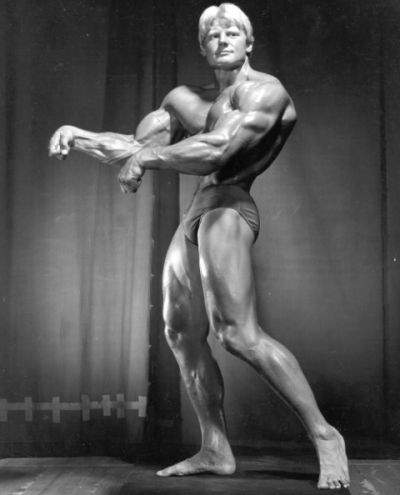Once Arnold set the bar for bodybuilding, it has only gone up. Competitive bodybuilders were becoming more muscular as an increasing emphasis on size dictated a more extreme approach to physical development. Anabolic steroids had been used during the 60s, and their use correspondingly increased as bodybuilding grew in popularity.
A general trend in aesthetics and balance gave way to a mass at all costs approach and top place getters generally were those carrying the most size, especially into the 90s and beyond 2000. The size of today’s Mr. Olympia compared to the one of 30 years ago might not be as aesthetically equal, but the difference in muscle mass and low body fat separates them into two whole different categories.
| Arnold was very big for his time and used steroids himself, yet compared to todays top competitors he is small in comparison. |
Although steroids were used prior to the 80s, the stacking of different types of steroid and use of dangerous levels of HGH and insulin were becoming commonplace as the 80s drew to a close. Amateurs and professionals alike engaged in this disturbing trend with the intention of making a name for themselves and increasing their earning potential.
With countries all over the world having different laws pertaining to the use of steroids and illegal substances in sporting events, it was often expected that the top competitors took steroids to match up to their opponents. With the number of steroid users rising, a new competition had to be made for the athletes who avoided illegal substances. Although the athletes in the category referred to as “natural” were much smaller in size when compared to the expected steroid using Mr. Olympians, they still had incredible aesthetics and muscle mass.
 |
| Natural bodybuilder Chad Shaw, much smaller than the steroid users who compete in the Mr. Olympia, yet he has great aesthetics. |
Undeniably, with the increase in competing bodybuilders came increased competition among these athletes. This meant that a great bodybuilder would have to become greater to distance themselves from the closest rival, who would be taking the same extreme approach to developing their physique.
As the 90s approached, the quality of physique improved due to advances in training techniques, dietary strategies and of, course, drugs. The 80s witnessed the rise of Lee Haney, who won seven Mr. Olympia's. His physique at around 240lbs had surpassed any other bodybuilder up until that point. When he retired, Haney had beaten Arnolds record of six Olympia's and, in the eyes of many other than my own, surpassed him in terms of muscular development.
The 90s could be defined as the era where competitors demonstrated a leap forward in terms of muscle mass. Dorian Yates won five Mr. Olympia's and heralded a new benchmark in mass at 265lbs. In fact, all professional bodybuilders of this time demonstrated a distinctly different, more massively defined, physique to that of any prior, as extreme practices prevailed. And just when everyone thought that Yates had redefined the massive physique, a man who would surpass him by more than 20lbs emerged.
Ronnie Coleman competes at around 290lbs and has taken the competition physique beyond what was, up until 10-years-ago, thought possible.
 |
| Ronnie Coleman - One of today's top body builders (alot bigger than prior years) |
 |
| 1970's bodybuilder Dave Draper has a large upper body and was a big competitor in his time, but pales in comparison to the size of today's greats like Ronnie. |
My Idol in the bodybuilding community, Arnold Schwarzenegger, played an active role in the sports development throughout the 90s and beyond. He began promoting the Arnold Schwarzenegger Classic bodybuilding championships in 1989, a contest that gradually incorporated other fitness-related events to become one of the most popular athletic events in the world.
Bodybuilding also became popularized through various media publications, most notably Muscle and Fitness magazine which hit the stands in 1980 and its offshoot Flex magazine, released in 1983.The fact that a media companies have bought publications and magazines, underscores the monumental impact bodybuilding has made since its inception.
The Internet has exploded with thousands of bodybuilding sites, many very professionally done, with worldwide followings. Bodybuilding.com ranks as probably the biggest and best of these, with thousands of articles and information on all aspects of the sport. It is a little known, and nearly underground community, but many people support bodybuilding while others look at it as an odd subject. As Arnold once said, “Many people think bodybuilding is weird, but it is normal to me. People just don’t know the sport because if they did they would love it! Going 7 seconds a quarter mile in a car is not normal for me, but for some it is.”
